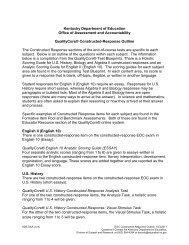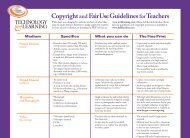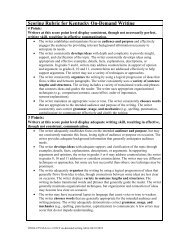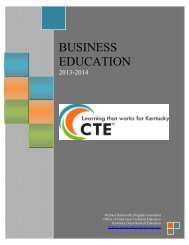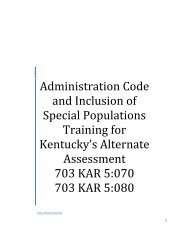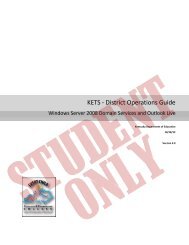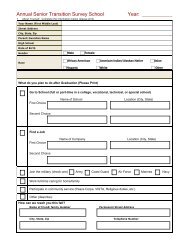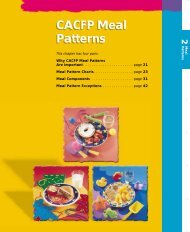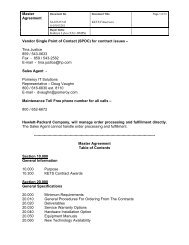Standards with Progressions grades K-HS v. 1.3 - Kentucky ...
Standards with Progressions grades K-HS v. 1.3 - Kentucky ...
Standards with Progressions grades K-HS v. 1.3 - Kentucky ...
- No tags were found...
You also want an ePaper? Increase the reach of your titles
YUMPU automatically turns print PDFs into web optimized ePapers that Google loves.
The Number System (continued)<br />
Grade 6 Grade 7 Grade 8<br />
6.NS.6: Understand a rational number as a point on the number line. Extend<br />
number line diagrams and coordinate axes familiar from previous <strong>grades</strong> to<br />
represent points on the line and in the plane <strong>with</strong> negative number<br />
coordinates.<br />
a. Recognize opposite signs of numbers as indicating locations on<br />
opposite sides of 0 on the number line; recognize that the opposite of<br />
the opposite of a number is the number itself, e.g., –(–3) = 3, and that<br />
0 is its own opposite.<br />
b. Understand signs of numbers in ordered pairs as indicating locations in<br />
quadrants of the coordinate plane; recognize that when two ordered<br />
pairs differ only by signs, the locations of the points are related by<br />
reflections across one or both axes.<br />
c. Find and position integers and other rational numbers on a horizontal<br />
or vertical number line diagram; find and position pairs of integers and<br />
other rational numbers on a coordinate plane.<br />
6.NS.7: Understand ordering and absolute value of rational numbers.<br />
a. Interpret statements of inequality as statements about the relative<br />
position of two numbers on a number line diagram. For example,<br />
interpret –3 > –7 as a statement that –3 is located to the right of –7<br />
on a number line oriented from left to right.<br />
b. Write, interpret, and explain statements of order for rational<br />
numbers in real-world contexts. For example, write –3° C > –7° C to<br />
express the fact that –3° C is warmer than –7° C.<br />
c. Understand the absolute value of a rational number as its distance<br />
from 0 on the number line; interpret absolute value as magnitude<br />
for a positive or negative quantity in a real-world situation. For<br />
example, for an account balance of –30 dollars, write |–30| = 30 to<br />
describe the size of the debt in dollars.<br />
d. Distinguish comparisons of absolute value from statements about<br />
order. For example, recognize that an account balance less than –30<br />
dollars represents a debt greater than 30 dollars.<br />
6.NS.8: Solve real-world and mathematical problems by graphing points in all<br />
four quadrants of the coordinate plane. Include use of coordinates and<br />
absolute value to find distances between points <strong>with</strong> the same first<br />
coordinate or the same second coordinate.<br />
7.NS.2:<br />
7.NS.3:<br />
Apply and extend previous understandings of multiplication and<br />
division and of fractions to multiply and divide rational numbers.<br />
a. Understand that multiplication is extended from fractions to<br />
rational numbers by requiring that operations continue to<br />
satisfy the properties of operations, particularly the<br />
distributive property, leading to products such as (–1)(–1) =<br />
1 and the rules for multiplying signed numbers. Interpret<br />
products of rational numbers by describing real-world<br />
contexts.<br />
b. Understand that integers can be divided, provided that the<br />
divisor is not zero, and every quotient of integers (<strong>with</strong> nonzero<br />
divisor) is a rational number. If p and q are integers,<br />
then –(p/q) = (–p)/q = p/(–q). Interpret quotients of rational<br />
numbers by describing real-world contexts.<br />
c. Apply properties of operations as strategies to multiply and<br />
divide rational numbers.<br />
d. Convert a rational number to a decimal using long division;<br />
know that the decimal form of a rational number terminates<br />
in 0s or eventually repeats.<br />
Solve real-world and mathematical problems involving the four<br />
operations <strong>with</strong> rational numbers. (NOTE: Computations <strong>with</strong><br />
rational numbers extend the rules for manipulating fractions to<br />
complex fractions.)<br />
<strong>Kentucky</strong> Department of Education<br />
35 | P a g e




